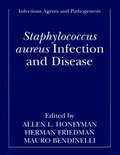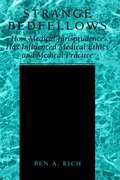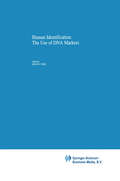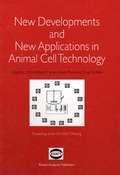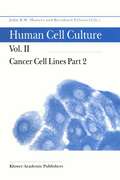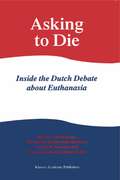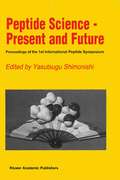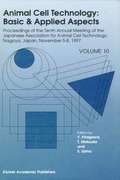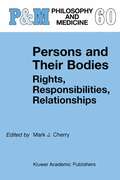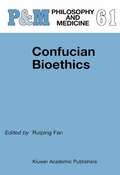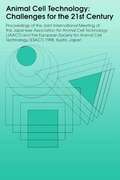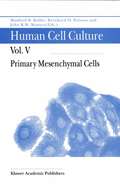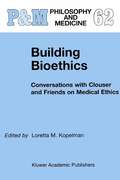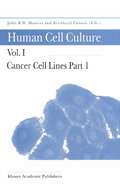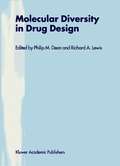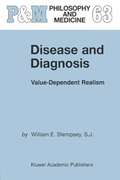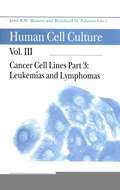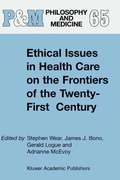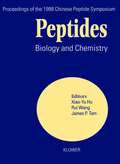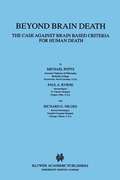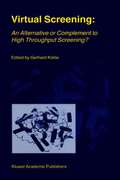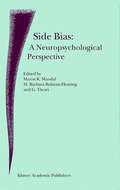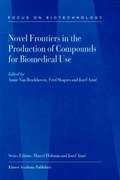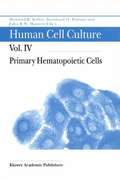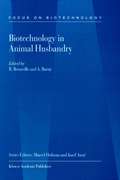- Table View
- List View
Staphylococcus aureus Infection and Disease (Infectious Agents and Pathogenesis)
by Allen Honeyman Herman Friedman Mauro BendinelliStaphylococcus aureus is now acknowledged as being the most important bacterial pathogen of humans. It usually produces localized disease but can be rapidly invasive, spreading through the tissues, invading bone, and seeding the bloodstream to produce a fulminant picture of septic shock, disseminated intravascular coagulation, and rapid death. Moreover, most strains of staph infections are becoming resistant to most antibiotics, thus posing a significant problem for hospitals and health care facilities. This book, a volume in the Infectious Agents and Pathogenesis series, presents chapters by the major researchers in the field.
Strange Bedfellows: How Medical Jurisprudence Has Influenced Medical Ethics and Medical Practice
by Ben A. RichThe pervasive influence of law on medical practice and clinical bioethics is often noted with a combination of exasperation and lamentation. Physicians and non-physician bioethicists, generally speaking, consider the willingness of courts, legislatures, and regulatory agencies to insinuate themselves into clinical practice and medical research to be a distinctly negative aspect of contemporary American society. They are quick to point out that their colleagues in other Western developed nations are not similarly afflicted, and that the situation which obtains elsewhere is highly preferable to the legalization and purported over-regulation of medicine that has taken place in the United States during the last fifty years. In this book I offer a decidedly different perspective. It is, admittedly, not entirely without personal and professional bias. Prior to becoming a fu- time academic, teaching bioethics in the setting of an academic medical center, I was, for nearly 20 years, an attorney specializing in health law. Even after earning a doctorate in philosophy, I was frequently considered to be the “resident lawyer” on the bioethics faculty, much more frequently looked to for my insights on the law than my perspective as one who had formally studied moral philosophy and applied ethics. I note this not out ofa sense of frustration or disappointment, but as confirmation that even among physicians and n- physician bioethicists, there is widespread recognition that the law does have important contributions to make in assessing the practice ofmedicine and the conduct of medical research.
Human Identification: The Use Of Dna Markers (Contemporary Issues in Genetics and Evolution #4)
by B. S. WeirThe ongoing debate on the use of DNA profiles to identify perpetrators in criminal investigations or fathers in paternity disputes has too often been conducted with no regard to sound statistical, genetic or legal reasoning. The contributors to Human Identification: The Use of DNA Markers all have considerable experience in forensic science, statistical genetics or jurimetrics, and many of them have had to explain the scientific issues involved in using DNA profiles to judges and juries. Although the authors hold differing views on some of the issues, they have all produced accounts which pay due attention to the, sometimes troubling, issues of independence of components of the profiles and of population substructures. The book presents the considerable evolution of ideas that has occurred since the 1992 Report of the National Research Council of the U.S. Audience: Indispensable to forensic scientists, laying out the concepts to all those with an interest in the use of genetic information. The chapters and exhaustive bibliography are vital information for all lawyers who must prosecute or defend DNA cases, and to judges trying such cases.
New Developments and New Applications in Animal Cell Technology: Proceedings of the 15th ESACT Meeting
by Otto-Wilhelm Merten Pierre Perrin Bryan GriffithsAnimal cell technology is becoming an increasingly important part of biotechnology and many products are now used in human health care and for veterinary applications. However, there are many times more products actually in the developmental pipelines of the biotechnology industry, including various phases of clinical trials. The Proceedings of the 15th Meeting of the European Society for Animal Cell Technology (Tours, France, September 1997) presents the actual current state as well as New Developments and Applications in Animal Cell Technology for the benefit of society. These Proceedings represent both the current state and applications of animal cell technology and the way the technology is expanding into new areas to give a unique insight into new products and applications for human and animal health care.
Cancer Cell Lines Part 2 (Human Cell Culture #2)
by John Masters Bernhard Ø. PalssonContinuous cell lines derived from human cancers are the mostwidely used resource in laboratory-based cancer research. The first 3 volumes of this series on Human Cell Culture are devoted to these cancer cell lines. The chapters in these first 3 volumes have a common aim. Their purpose is to address 3 questions offundamental importance to the relevanceof human cancer cell lines as model systems of each type of cancer: 1. Do the cell lines available accurately represent the clinical presentation? 2. Do the cell lines accurately represent the histopathology of the original tumors? 3. Do the cell lines accurately represent the molecular genetics of this type of cancer? The cancer cell lines available are derived, in most cases, from the more aggressive and advanced cancers. There are few cell lines derived from low grade organ-confined cancers. This gap can be filled with conditionally immortalized human cancer cell lines. We do not know why the success rate for establishing cell lines is so low for some types of cancer and so high for others. The histopathology of the tumor of origin and the extent to which the derived cell line retains the differentiated features of that tumor are critical. The concept that a single cell line derived from a tumor at a particular site is representative oftumors at that site is naïve and misleading.
Asking to Die: Inside The Dutch Debate About Euthanasia
by David C. Thomasma Thomasine Kimbrough-Kushner Gerrit K. Kimsma Chris Ciesielski-Carlucciclaim was that he had faced a conflict of duties pitting his legal duty not to kill against his duty as a physician to relieve his patient’s unbearable suffering. He was acquitted on the important grounds of conflict of duty. These grounds are based on a concept in Dutch law called "force majeure" 4 which recognizes extenuating circumstances such as conflicts of duty. The acquittal was upheld by the Lower Court of Alkmaar, but revoked by an Amsterdam court of appeal. The case went on to the Supreme Court, but before the Supreme Court's decision was issued, the Royal Dutch Medical Association (RDMA) attempted to clarify the criteria for euthanasia that many within the profession already accepted. The RDMA proposed that physicians be permitted to perform euthanasia provided that a set of procedures had been met. Variously stated, the guidelines contain the following central provisions: Voluntary, competent, explicit, and persistent requests on the part of the • patient; Requests based on full information; • The patient is in a situation of intolerable and hopeless suffering (either • physical or mental); No further acceptable alternatives to euthanasia. All alternatives • acceptable to the patient for relief of suffering having been tried; Consultation with at least one other physician whose judgment can be • 5 expected to be independent. Indirectly, these guidelines became the criteria prosecutors used to decide whether or not to bring charges.
Peptide Science — Present and Future: Proceedings of the 1st International Peptide Symposium
by Yasutsugu ShimonishiIn the late 1980s, Peptide Societies were established in Europe, the United States, and Japan, and more recently, in the Asian and the Pacific Rim regions including Australia, China, and Korea. At the time of the establishment of the American, European and Japanese Peptide Societies, the International Liaison Organizing Committee representing these Peptide Societies, along with the Australian Peptide Society, began discussions for holding international confer ences which would supercede or be held in lieu of the numerous individual meetings, held by the peptide societies of each individual country or region. The representative of the Chinese Peptide Society participated in these discus sion in the International Liaison Organizing Committee at the meeting of the American Peptide Symposium in Nashville, in June 1997. After lengthy discus sions over several years, we agreed to organize and host the International Peptide Symposium in Japan. The First International Peptide Symposium (IPS’97) was held on November 30–December 5, 1997, in Kyoto, and was co sponsored by four Peptide Societies. The attendance at this Symposium was 550 participants, including representatives from 32 different countries. We were very pleased with this outcome and anticipate an even larger attendance for forthcoming Symposia in future years. The revolution and advances in science and technology during the past two decades has caused traditional peptide chemistry to expand to peptide science, spreading from physical science to biology, pharmacology, and medicine.
Animal Cell Technology: Proceedings of the Tenth Annual Meeting of the Japanese Association for Animal Cell Technology, Nagoya, November 5–8, 1997 (Animal Cell Technology: Basic & Applied Aspects #1)
by Y. Kitagawa T. Matsuda S. IijimaAnimal cell technology is a growing discipline of cell biology which aims not only to understand structures, functions and behaviors of differentiated animal cells but also to ascertain their abilities to be used for industrial and medical purposes. The goal of animal cell technology includes accomplishments of clonal expansion of differentiated cells with useful ability, optimization of their culture conditions, modulation of their ability for production of medically and pharmaceutically important proteins, and the application of animal cells to gene therapy and artificial organs. This Volume gives the readers a complete review of the present state of the art in Japan. The Proceedings will be useful for cell biologists, biochemists, molecular biologists, immunologists, biochemical engineers and other disciplines related to animal cell culture, working either in academic environments or in industries of biotechnology and pharmacy.
Persons and Their Bodies: Rights, Responsibilities, Relationships (Philosophy and Medicine #60)
by Mark J. CherryDebate regarding organ sales is largely innocent of the history of thought on the matter. This volume seeks to remedy this shortcoming. Positions for or against a market in human organs are nested within moral intuitions, ontological or political theoretical premises, or understandings of special moral concerns, such as permissible uses of the body, which have a long history of analysis. The essays compass the views of Plato, Aristotle, Aquinas, Locke, Kant, Hegel, Mill and Christianity, as well as particular methodological approaches, such as the phenomenology of the body, natural law theory, legal theory and libertarian critique of legal theory. These discussions cluster a number of conceptually independent philosophical concerns: (1) What is the appropriate understanding of the relationship between persons and their bodies? (2) What does it mean to `own' an organ? (3) Do governments have moral authority to regulate how persons use their own body parts? (4) What are the costs and benefits of a market in human organs? Such questions are related by an urgent public health challenge: the considerable disparity between the number of patients who could significantly benefit from organ transplantation and the number of human organs available for transplantation. This volume explores the theoretical, normative, and historical foundations for alternative policies for procurement and transplantation of human organs.
Confucian Bioethics (Philosophy and Medicine #61)
by Ruiping FanThis volume explores Confucian views regarding the human body, health, virtue, suffering, suicide, euthanasia, `human drugs,' human experimentation, and justice in health care distribution. These views are rooted in Confucian metaphysical, cosmological, and moral convictions, which stand in contrast to modern Western liberal perspectives in a number of important ways. In the contemporary world, a wide variety of different moral traditions flourish; there is real moral diversity. Given this circumstance, difficult and even painful ethical conflicts often occur between the East and the West with regard to the issues of life, birth, reproduction, and death. The essays in this volume analyze the ways in which Confucian bioethics can clarify important moral concepts, provide arguments, and offer ethical guidance. The volume should be of interest to both general readers coming afresh to the study of bioethics, ethics, and Confucianism, as well as for philosophers, ethicists, and other scholars already familiar with the subject.
Animal Cell Technology: Proceedings of the joint international meeting of the Japanese Association for Animal Cell Technology (JAACT) and the European Society for Animal Cell Technology (ESACT) 1998, Kyoto, Japan
by Kouji Ikura Seiji Masuda Masaya Nagao Ryuzo SasakiAnimal cell technology aims to understand structures, functions, and behaviors of differentiated animal cells and to ascertain their abilities to be used in industrial and medical purposes. This volume gives readers a complete review of the present state of the art in Japan.
Primary Mesenchymal Cells (Human Cell Culture #5)
by Bernhard Ø. Palsson F. Koller John MastersThe human body contains many specialized tissues that are capable of fulfilling an incredible variety of functions necessary for our survival. This volume in the Human Cell Culture Series focuses on mesenchymal tissues and cells. The in vitro study of mesenchymal cells is perhaps the oldest form of human cell culture, beginning with the culturing of fibroblasts. Fibroblasts have long been generically described in the literature, arising from many tissue types upon in vitro cell culture. However, recent studies, many enabled by new molecular biology techniques, have shown considerable diversity in fibroblast type and function, as described within this volume. Mesenchymal tissue types that are described within include bone, cartilage, tendons and ligaments, muscle, adipose tissue, and skin (dermis). The proper function of these tissues is predominantly dependent upon the proper proliferation, differentiation, and function of the mesenchymal cells which make up the tissue. Recent advancements in primary human mesenchymal cell culture have led to remarkable progress in the study of these tissues. Landmark experiments have now demonstrated a stem cell basis for many of these tissues, and, furthermore, significant plasticity and inter-conversion of stem cells between these tissues, resulting in a great deal of contemporary excitement and controversy. Newly-developed mesenchymal cell culture techniques have even lead to novel clinical practices for the treatment of disease.
Building Bioethics: Conversations with Clouser and Friends on Medical Ethics (Philosophy and Medicine #62)
by Loretta M. KopelmanK. Danner Clouser is one of the most important figures in establishing and shaping the fields of medical ethics, bioethics, and the philosophy of education in the second half of the twentieth century. Clouser challenged many established approaches to moral theory and offered innovative strategies for integrating the humanities into professional education, especially that of physicians and nurses. The contributions published in Building Bioethics: Conversations with Clouser and Friends on Medical Ethics are unique both in their devotion to a critical review of his contributions, and in bringing together internationally known figures in bioethics, medical ethics, and philosophy of medicine to comment upon Clouser's work. These leaders of the field include Tom Beauchamp, Daniel Callahan, James Childress, Nancy Dubler, H. Tristram Engelhardt, Al Jonsen, Loretta Kopelman, Larry McCullough, John Moskop, and Robert Veatch. This book merits special attention from those interested in bioethics, philosophy of medicine, medical ethics, philosophy, medical education, religious studies, and nursing education.
Cancer Cell Lines Part 1 (Human Cell Culture #1)
by John R. W. Masters Bernhard Ø. PalssonContinuous cell lines derived from human cancers are the most widely used resource in laboratory-based cancer research. The first 3 volumes of this series on Human Cell Culture are devoted to these cancer cell lines. The chapters in these first 3 volumes have a common aim. Their purpose is to address 3 questions of fundamental importance to the relevance of human cancer cell lines as model systems of each type of cancer: 1. Do the cell lines available accurately represent the clinical presentation? 2. Do the cell lines accurately represent the histopathology of the original tumors? 3. Do the cell lines accurately represent the molecular genetics of this type of cancer? The cancer cell lines available are derived, in most cases, from the more aggressive and advanced cancers. There are few cell lines derived from low grade organ-confined cancers. This gap can be filled with conditionally immortalized human cancer cell lines. We do not know why the success rate for establishing cell lines is so low for some types of cancer and so high for others. The histopathology of the tumor of origin and the extent to which the derived cell line retains the differentiated features of that tumor are critical. The concept that a single cell line derived from a tumor at a particular site is representative of tumors at that site is naïve and misleading.
Molecular Diversity in Drug Design
by P. M. Dean R. A. LewisHigh-throughput screening and combinatorial chemistry are two of the most potent weapons ever to have been used in the discovery of new drugs. At a stroke, it seems to be possible to synthesise more molecules in a month than have previously been made in the whole of the distinguished history of organic chemistry, Furthermore, all the molecules can be screened in the same short period. However, like any weapons of immense power, these techniques must be used with care, to achieve maximum impact. The costs of implementing and running high-throughput screening and combinatorial chemistry are high, as large dedicated facilities must be built and staffed. In addition, the sheer number of chemical leads generated may overwhelm the lead optimisation teams in a hail of friendly fire. Mother nature has not entirely surrendered, as the number of building blocks that could be used to build libraries would require more atoms than there are in the universe. In addition, the progress made by the Human Genome Project has uncovered many proteins with different functions but related binding sites, creating issues of selectivity. Advances in the new field of pharmacogenomics will produce more of these challenges. There is a real need to make hi- throughput screening and combinatorial chemistry into 'smart' weapons, so that their power is not dissipated. That is the challenge for modellers, computational chemists, cheminformaticians and IT experts. In this book, we have broken down this grand challenge into key tasks.
Disease and Diagnosis: Value-Dependent Realism (Philosophy and Medicine #63)
by William E. StempseyThe germs of the ideas in this book became implanted in me during my experience as a resident in clinical pathology at Boston University Medical Center. At the time, I had inklings that the test results churned out by our laboratories were more than scientific facts. As a philosophically unsophisticated young physician, however, I had no language or framework to analyze what I saw as a deep philosophical problem, a problem largely unrecognized by most physicians. The test results provided by our laboratories were accurate and of great practical importance for patient care. However, most of the physicians who relied on our test results to diagnose and treat their patients either did not have the time or interest to consider the philosophical issues inherent in diagnosis, or, like me, had inadequate means to further analyze them. It was more than ten years later that I began doctoral studies in philosophy, and I was fortunate to find a faculty that was supportive ofmy efforts to address the problem. This book began as my doctoral dissertation in the Department of Philosophy at Georgetown University. I would like to acknowledge the assistance of my mentor, Robert Veatch, Ph. D. Our conversations during my Georgetown years led me in new and often fascinating directions. I would also like to acknowledge the help of Kenneth Schaffner, M. D. , Ph. D.
Cancer Cell Lines: Part 3: Leukemias and Lymphomas (Human Cell Culture #3)
by John Masters Bernhard Ø. PalssonThis book describes all human leukemia-lymphoma cell lines that have been established and that grow continuously under standardised in vitro conditions. These lines are derived from cells belonging to all the major hematopoietic cell lineages, i.e. B- and T-lymphocytes, natural killer cells, granulocytic cells and megakaryocytic cells. The clinical data, the culture conditions and the major phenotypic features of the cell lines are described with citations. This book is the first book describing human leukemia-lymphoma cell lines and will be of interest to scientists involved in the areas of hematology, oncology, immunology, molecular biology and cytogenetics. Cancer Cell Lines, Volumes 1-3: These 3 volumes provide a comprehensive text on the culture of established cell lines from every type of human cancer. The volumes provide a basic manual and reference resource for every cancer research scientist using human cancer cells.
Ethical Issues in Health Care on the Frontiers of the Twenty-First Century (Philosophy and Medicine #65)
by Stephen Wearof UB’s medical school, that UB developed its School of Arts and Sciences, and thus, assumed its place among the other institutions of higher education. Had Fillmore lived throughout UB’s first seventy years, he would probably have been elated by the success of his university, and he should have been satisfied and pleased that UB remained intrinsically bonded to its community while at the same time engrafting the values and standards important to higher education’s mission in the region. UB and its medical school have undergone many challenging transitions since 1846. Included among them were: (1) the completion of an academic campus in the far northeast comer of the City of Buffalo while leaving its medical, dental and law schools firmly situated in the core of downtown Buffalo; (2) the eventual relocation, after the second world war, of the law school to the newer campus in Amherst, and the medical and dental school to the original academic campus: and (3) the merger with the State University of New York System in 1962. Despite these significant transitions, any one of which could have changed the intrinsic integrity of UB and disrupted the bonding between community and university, that did not happen. To this day, the ties between community and academe persist. Fillmore and White should celebrate their success and important contribution to Buffalo and Western New York.
Peptides: Biology and Chemistry (Chinese Peptide Symposia)
by James P. Tam Xiao-Yu Xiao-Yu Hu Rui Rui WangThe Fifth Chinese Peptide Symposium, hosted by Lanzhou University, was held at Lanzhou, China July 14-17, 1998, with 156 participants, including 30 scientists from abroad, representing nine countries. The four-day conference was both intense and spiritually rewarding. Our goal for CPS-98 was to provide a forum for the exchange of knowledge, cooperation and friendship between the international and Chinese scientific communities, and we believe this goal was met. The symposium consisted of 8 sessions with 42 oral and 90 poster presentations, including synthetic methods, molecular diversity and peptide libraries, structure and conformation of peptides and proteins, bioactive peptides, peptide immunology, De Novo design and synthesis of proteins and peptides, ligand-receptor interactions, the chemistry-biology-interface and challenging problems in peptides. The enthusiastic cooperation and excellent contributions were gratifying and the active response of the invited speakers contributed to the success of the symposium. The presentations were of excellent caliber and represented the most current and significant aspects of peptide science. Dr. Kit Lam of the University of Arizona and Dr. Yun-Hua Ye of Peking University were the recipients of “The Cathay Award” sponsored by the H. H. Liu Education Foundation, offered for their seminal contribution in peptide science and the Chinese Peptide Symposium. Four outstanding young scientists were selected by the organizing committee to receive awards sponsored by Haikou Nanhai Pharmaceutical Industry Co. Ltd. (Zhong He Group).
Beyond Brain Death: The Case Against Brain Based Criteria for Human Death (Philosophy and Medicine #66)
by P. A. Byrne R. G. Nilges M. PottsBeyond Brain Death offers a provocative challenge to one of the most widely accepted conclusions of contemporary bioethics: the position that brain death marks the death of the human person. Eleven chapters by physicians, philosophers, and theologians present the case against brain-based criteria for human death. Each author believes that this position calls into question the moral acceptability of the transplantation of unpaired vital organs from brain-dead patients who have continuing function of the circulatory system. One strength of the book is its international approach to the question: contributors are from the United States, the United Kingdom, Liechtenstein, and Japan. This book will appeal to a wide audience, including physicians and other health care professionals, philosophers, theologians, medical sociologists, and social workers.
Virtual Screening: Proceedings of the Workshop ‘New Approaches in Drug Design and Discovery’, special topic ‘Virtual Screening’, Schloß Rauischholzhausen, Germany, March 15–18, 1999
by Gerhard KlebeIn the next couple of years the human genome will be fully sequenced. This will provide us with the sequence and overall function of all human genes as well as the complete genome for many micro-organisms. Subsequently it is hoped, by means of powerful bioinformatic tools, to determine the gene variants that contribute to various multifactorial diseases and genes that exist in certain infectious agents but not humans. As a consequence, this will allow us to define the most appropriate levels for drug intervention. It can be expected that the number of potential drug targets will increase, possibly by a factor of 10 or more. Nevertheless, sequencing the human genome or, for that matter, the genome of other species will only be the starting point for the understanding of their biological function. Structural genomics is a likely follow-up, combined with new techniques to validate the therapeutic relevance of such newly discovered targets. Accordingly, it can be expected that in the near future we will witness a substantial increase in novel putative targets for drugs. To address these new targets effectively, we require new approaches and innovative tools. At present, two alternative, yet complementary, techniques are employed: experimental high-throughput screening (HTS) of large compound libraries, increasingly provided by combinatorial chemistry, and computational methods for virtual screening and de novo design. As kind of status report on the maturity of virtual screening as a technique in drug design, the first workshop on new approaches in drug design and discovery was held in March 1999, at Schloß Rauischholzhausen, near Marburg in Germany. More than 80 scientists gathered and discussed their experience with the different techniques. The speakers were invited to summarize their contributions together with their impressions on the present applicability of their approach. Several of the speakers followed this request which is summarized in this publication.
Side Bias: A Neuropsychological Perspective
by Manas K. Mandal`Rather than being an esoteric aspect of brain function, lateralization is a fundamental characteristic of the vertebrate brain essential to a broad range of neural and behavioral processes.' Professor Lesley J. Rogers, Chapter 1 of Side Bias: A Neuropsychological Perspective. This volume contains 14 chapters from a veritable `United Nations' of experts in the field of lateralization of function. They write comprehensive reviews, present data, and pose new questions concerning the evolutionary origins and development of side bias, methodological concerns with the way we measure handedness and footedness, and some more unusual aspects of human beings' lateralized behavior, such as asymmetrical cradling and pseudoneglect. The book will be essential reading for students of behavioral neuroscience and neuropsychology interested in lateralization of function as well as for established researchers in the field.
Novel Frontiers in the Production of Compounds for Biomedical Use (Focus on Biotechnology #1)
by Fred Shapiro Jozef Anné A. Van BroekhovenThe present book entitled “Novel Frontiers in the Production of Compounds for Biomedical Uses” can perhaps be placed in its best perspective by the Shakespearean character in The Tempest who exclaimed" What’s past is prologue”. Indeed, this compilation of some of the outstanding presentations in the field of biomedicine made at th the 9 European Congress on Biotechnology (Brussels, Belgium, July 11-15, 1999) not only reflects the achievements of the recent past, but provides a privileged glimpse of the biotechnology that is emerging in the first decade of the new Millennium. It is becoming increasingly apparent that biotechnology is offering biomedicine novel approaches and solutions to develop a sorely needed new generation of biopharmaceuticals. This is all the more necessary because in recent years, new diseases have emerged with extraordinary lethality in all corners of the globe, while age-related chronic illnesses have filled the gap wherever biomedicine has made successful inroads. The rise of antibiotic resistance also poses major threats to public health. Thus, as disease patterns evolve, the rational development of new drugs is becoming urgent, not only for the clinical outcome of patients, but also in optimising the allocation of scarce health care resources through the use of cost-effective productions methods. It is in response to all these challenges that biotechnology offers new strategies that go beyond the more traditional approaches. By the mid-1990’s, the number of recombinant products approved annually for therapeutic use reached double digits. With the advent of the genomics revolution.
Human Cell Culture: Primary Hematopoietic Cells (Human Cell Culture #4)
by Bernhard Ø. Palsson F. Koller John MastersThe daily production of hundreds of billions of blood cells through the process of hematopoiesis is a remarkable feat of human physiology. Transport of oxygen to tissues, blood clotting, antibody- and cellular-mediated immunity, bone remodeling, and a host of other functions in the body are dependent on a properly functioning hematopoietic system. As a consequence, many pathological conditions are attributable to blood cell abnormalities, and a fair number of these are now clinically treatable as a direct result of hematopoietic research. Proliferation of hematopoietic stem cells, and their differentiation into the many different lineages of functional mature cells, is highly regulated and responsive to many environmental and physiological challenges. Our relatively advanced understanding of this stem cell system provides potentially important insights into the regulation of development in other tissues, many of which are now being acknowledged as stem ce- based, perhaps even into adulthood. The recent public and scientific fanfare following announcement of human embryonic stem cell studies suggests that stem cell research will continue to be a relevant and exciting topic.
Biotechnology in Animal Husbandry (Focus on Biotechnology #5)
by R. Renaville A. BurnyAnimal biotechnology is a broad umbrella encompassing the polarities of fundamental and applied research including molecular modelling, molecular and quantitative genetics, gene manipulation, development of diagnostics and vaccines and manipulation of tissue or digestion metabolism by growth promoters. Although animal biotechnology in the broadest sense is not new, what is new is the level of complexity and precision involved in scientists' current ability to manipulate living organisms. This new book sets out to show that the important ideas in animal biotechnology are exciting and relevant to everyday experience. It represents an important update of the literature for research workers, lecturers, and advisers in animal science, but is also a core text for advanced undergraduate courses in animal science and biotechnology. It will be an essential acquisition for librarians in agriculture and veterinary science.
